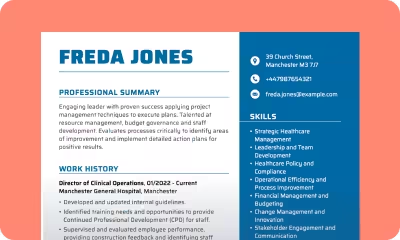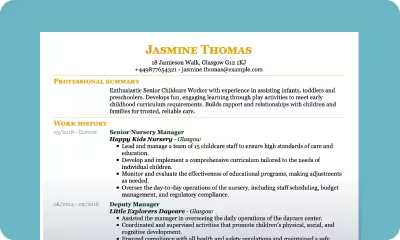Arts CV Examples for All Art Jobs in 2025
Creating an arts CV for roles in the artistic industry requires a strategic focus on creativity, attention to detail, and relevant experience. This step-by-step guide offers tailored advice for roles such as gallery assistant, curator, or artist, helping you to showcase your skills and stand out to recruiters.

- Our customers have been hired by : * Foot Note
The primary purpose of an arts CV is to present an artist’s professional achievements and credentials, making it an essential tool when applying for arts opportunities such as exhibitions, residencies, and grants. This type of CV provides potential employers or collaborators with a detailed overview of an artist’s career, community involvement, and contributions to public artistic discourse. Read on to see examples of CVs from this and other fields to learn what makes a good arts CV.
SEARCH ALL CV EXAMPLES
Arts CV templates
Looking to land your next role in the vibrant art industry? Explore our range of art CV templates designed specifically for various art-related positions. Browse through these examples to discover the best format, structure, and key CV sections that will catch the attention of recruiters and make your arts CV stand out from the rest.
Create a new CV with myPerfectCV
Our CV builder can help you create the ideal CV for your industry. Start now!
Arts CV examples for art-related jobs
The art industry offers a range of exciting roles, each requiring a tailored CV to highlight the specific skills and experience employers are looking for. Customising your art CV to showcase your unique artistic abilities and creative experience is key to standing out. Below, you’ll find examples of CVs for various art-related positions, with insights into what makes them compelling to recruiters.
Photographer CV
This photographer’s CV is a fantastic example of how to present relevant work experience and skills in a clean, modern design. The pop of colour adds a touch of personality while keeping the layout professional and easy to navigate. Recruiters can quickly identify key sections, such as the candidate’s photography portfolio, work experience, and technical skills.
The CV highlights the candidate’s practical experience, showcasing their ability to capture high-quality images in various settings and for diverse clients. It also includes a skills section that emphasises expertise in photography equipment, editing software, and creative direction, all essential for a successful career in photography.
Fashion designer CV
This fashion designer’s CV features a simple yet clean layout that highlights the candidate’s creative and technical expertise. With a focus on skills and work experience, the layout ensures that recruiters can easily navigate and find key information.
The CV emphasises the designer’s hands-on experience in the fashion industry, showcasing their ability to design collections, collaborate with teams, and stay on trend. It goes beyond just listing job duties, incorporating specific examples of successful projects, such as launching new lines or working with notable clients. The work experience section is rich with details that demonstrate the candidate’s design process, innovation, and ability to meet deadlines, all of which are essential for success in the competitive fashion industry.
Gallery assistant CV
This gallery assistant CV features a simple yet modern design, with a clean and easy-to-navigate layout. The minimalistic approach ensures that recruiters can quickly access the key information without any distractions.
The CV effectively highlights the candidate’s relevant experience in the art world, focusing on skills like customer service, inventory management, and exhibition assistance. It also draws attention to the candidate’s ability to assist in organising art exhibitions and working with artists and curators. A key strength of the CV is its emphasis on organisational skills, helping recruiters see the candidate’s capacity to thrive in a gallery setting.
View our selection of professional creative CV templates and find the right one for your career.
How to write an arts CV step-by-step
In this step-by-step guide, we’ll show you how to create a CV that effectively highlights your artistic skills and experience. Whether you’re an artist, curator, or gallery assistant, we’ll guide you on what to include and how to present your qualifications in a way that catches the attention of employers in the creative industry.
List your contact details
Your contact details should be clear and easy to find, ideally located at the top of your arts CV. Include your full name, contact number, email address, and location.
Example of a contact section:
Elana Walls
07912 345 678
elana.walls@example.co.uk
London
Write your personal statement
A personal statement on your art CV should briefly introduce you and clearly articulate your artistic identity, setting the stage for your expertise. State your career goals to align your artistic aspirations with the potential employer’s goals, and show how you intend to contribute and grow. Don’t forget to highlight your active involvement in the arts community, demonstrating your experience and commitment to collaborative and shared artistic endeavours.
Personal statement for a visual artist:
Innovative visual arts professional with a solid background in creative design, adept at transforming client concepts into distinctive works of art using a wide range of styles and techniques. Highly skilled in creating unique, bespoke pieces to meet specific personal or commercial requirements. Dedicated and passionate, I focus on delivering tailored, one-off creations that exceed expectations and resonate personally with each client.
OR
Personal statement for a photographer:
Accomplished food photographer with over eight years of experience, skilled in traditional and contemporary photographic techniques. Proficient in capturing and editing images to meet specific aesthetic requirements and functional uses. Committed to exceeding client expectations by delivering images with impeccable colour accuracy, clarity, and precise framing.
List your work experience
The experience section of your arts CV is crucial in demonstrating your professional development and the specific skills relevant to the roles you are targeting. It’s essential to highlight positions directly relevant to the job you’re applying for, such as studio assistantships, artist residencies, art teaching, or your involvement in exhibitions. For each role, clearly outline your responsibilities and highlight any significant achievements to give potential employers a comprehensive view of your skills. For each role, include:
- Job title
- Company name
- Location
- Dates employed
- Key responsibilities
Tip: For art-based roles, showcasing measurable results can help demonstrate your impact. Whether you’re highlighting successful exhibitions, increased gallery foot traffic, or enhanced sales, using specific metrics helps recruiters see the tangible value you contribute
Example of an experience section for a fashion designer:
Senior Fashion Designer
Vivid Fashion House, London
March 2019 – Present
- Led the design and development of seasonal collections, overseeing a team of 10 junior designers and technicians to ensure high-quality production.
- Worked closely with fabric suppliers to source sustainable materials, contributing to a 20% reduction in the company’s environmental impact.
- Spearheaded the womenswear line for fashion week events, resulting in a 30% increase in brand awareness and subsequent sales.
Fashion Designer
Trendsetters Apparel, Manchester
August 2014 – February 2019
- Designed and launched over 50 pieces per year for the casual wear line, closely monitoring market trends to guide the direction of the collection.
- Managed the full lifecycle of garment production from sketch to store, improving supply chain efficiency by 15%.
- Conducted consumer and market research to inform designs, resulting in a best-selling collection that accounted for 25% of the company’s annual profit.
Showcase your skills
The skills section of an arts CV is designed to demonstrate both your artistic ability and your professional aptitude. Start by listing the technical, hard skills relevant to your field, such as proficiency with specific software for graphic artists or mastery of certain materials for sculptors. Next, mention your creative techniques, highlighting the unique artistic styles or methods you specialise in.
Soft skills are also important. Include skills such as critical thinking, effective communication, and adaptability to show how you handle creative projects and collaborations. If this applies to you, add business-oriented skills such as project management or budgeting, which are valuable for leadership roles or freelance work.
Tip: Including skills that match the job description can improve your chances of passing applicant tracking systems (ATS), which scan for specific keywords.
Example of skills to include on your arts CV:
Hard skills:
- In-depth understanding of art curation, exhibition planning, and gallery management.
- Proficiency with art management software, cataloguing systems, and digital portfolios.
- Expertise in coordinating art shipments, framing, and installation processes.
- Ability to optimise art sales and improve customer experience in galleries or online platforms.
- Knowledge of art conservation methods, copyright laws, and provenance documentation.
Soft skills:
- Strong communication and interpersonal skills, fostering relationships with artists, clients, and collectors.
- Exceptional problem-solving abilities in high-pressure exhibition setups or sales scenarios.
- Active listening to understand the unique needs of artists, buyers, and patrons.
- Empathy and emotional intelligence when interacting with clients and stakeholders.
- High adaptability to changing trends, art preferences, and project needs.
- Collaborative teamwork skills.
- Excellent customer service, ensuring clients feel valued and informed in art dealings.
Showcase your education and qualifications
The education section is an important part of an arts CV as it is evidence that you have the skills and knowledge essential to your art form. Especially important when starting out, degrees from recognised schools add credibility and demonstrate your commitment. Specialising in areas such as digital media or sculpture during your studies can make you more attractive to potential employers or galleries. Art schools are great for networking and offering connections that can lead to jobs and collaborations.
Here’s what to include in your education section:
- Degree or qualification
- Institution name
- Dates attended (month and year)
- Key achievements or relevant courses (if applicable)
Example of education for a fashion designer:
Bachelor of Arts in Fashion Design
Central Saint Martins, University of the Arts London, London
Graduated: July 2018
Diploma in Textile Design
London College of Fashion, London
Graduated: May 2015
It only takes
MINUTES for an average MyPerfectCV user to create a CV
Create your new arts CV in 3 simple steps:
- Fill in a quick and easy form
- Tailor the CV to your needs
- Download and apply
*The names and logos of the companies referred to above are all trademarks of their respective holders. Unless specifically stated otherwise, such references are not intended to imply any affiliation or association with myperfectCV.




